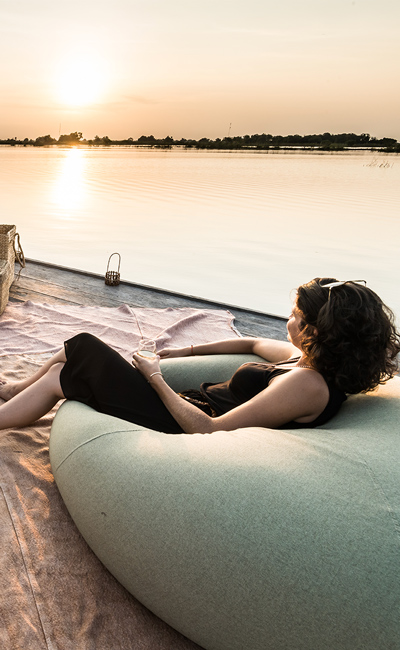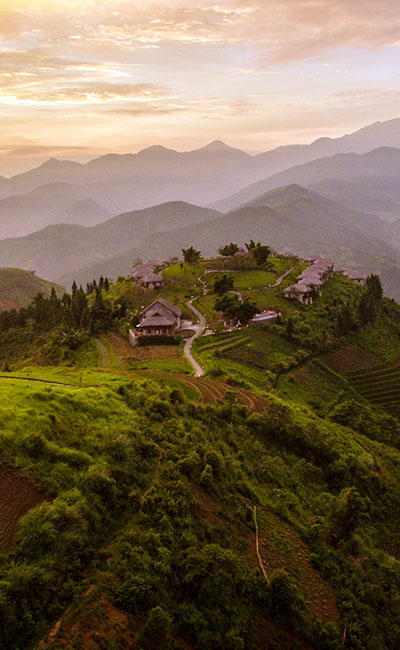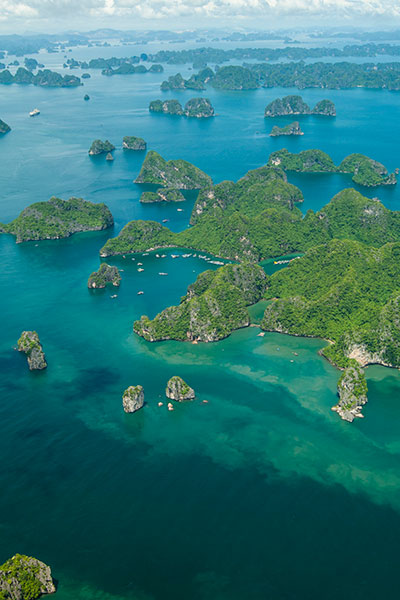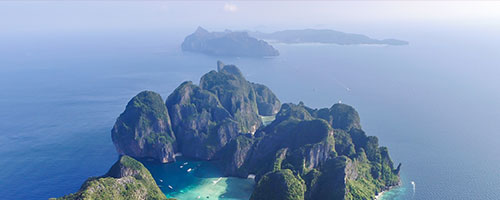LAOS – Savannakhet – Discover Xe Champhone
Xe Champhone district is home to the largest of Laos’ wetland areas of international importance as well as an interesting selection of other natural and cultural sites managed by the local communities.
Theme
Classic, Family, Sustainable
Country - City
Laos - Savannakhet
Market segment
Groups, Thematic Leisure
Price Level
$$
Level of difficulties
LEVEL 0
Max pax
12 for the full day tour / Split into groups of 6pax for the 2D1N option.
Seasonality
All Year Round
Arrival city
Savannakhet
Departure city
Savannakhet
Description
Xe Champhone district is home to the largest of Laos’ RAMSAR (international wetland convention) areas of international importance as well as a variety of other natural and cultural sites managed by the local communities. Easily visited as a day trip from Savannakhet or as a 2D1N trip with a night in a local homestay, a trip to this special and unique region offers visitors a chance to see a part of Laos that is rarely visited by tourists. It also provides a way to contribute to the protection of Laos’ biodiversity and provide local communities with a sustainable income, as well as the opportunity to discover a range of interesting natural and cultural sites unlike any others in Laos.
Natural sites on the visit include:
- Monkey Forest – a 23-hectare protected forest home to about 300 rhesus macaques, protected and revered by the locals as the forest is believed to be home to the village spirits. This is the only forest in Laos where visitors can easily encounter monkeys swinging through the trees.
- Turtle Lake – a small lake home to the largest concentration of endangered soft-shell turtles in Laos, thanks to villagers who protect them because they believe they are sacred.
- Soui Lake – Champhone district’s largest reservoir, sometimes called the Champhone Sea. It provides the locals with enough water to have two rice harvests per year and is an ideal place for lunch.
Cultural sites on the visit include:
- Nonglamchan Library – an ancient stilted library temple known as “Hotay Pidok” in the Lao language. It is famous for its wooden repository, which contains 400 palm leave manuscripts displayed in a traditional cabinet.
- Taleo Old Temple – a beautiful old temple famous for its church-like architecture, the frescoes on its inner walls, and the ruins of the monastic school on the temple grounds. Also home to a small museum to preserve the history of Taleo village during the American Secret War.
- Wat Phoukor (on the 2D1N visit) – a unique and curious forest temple with statues depicting scenes from Buddhist hell and famous Lao folk tales.
Selling points
- A unique experience in the wetlands of Laos, one of the country’s more untouched and undeveloped areas.
- The Xe Champhone area is home to several unique cultural, wildlife, and biodiversity experiences unlike any others in Laos.
- An excellent way to spend a day in the Savannakhet area and break up the long land transfer from Hinboun to Pakse.
- It can be done as a full-day activity, or as a 2-day-1-night activity with a night in a local homestay.
- It is possible to visit any time of the year.
- It’s easily accessible – the roads are good, and all the visits are easy and accessible to travelers of all ages and abilities.
- It can be a nice activity for families as a lot of wildlife can be seen.
Level Of The Excursion
High – This activity strongly supports local communities and/or helps preserve the culture and environment
The Impact Of This Excursion
Social/cultural Impact
Cultural Conservation
Empowerment and education
Homestays
Involving minorities
Community welfare and health
Environment Impact
Involving Wildlife
National parks
Economic Impact
Community benefits
Additional Information
Xe Champhone district is home to the largest of Lao PDR’s two RAMSAR wetland areas of international importance: the Xe Champhone Wetlands.
“A large plain consisting of marshes, swamps, and flooded woodland forest. The site is an outstanding example of a river with many oxbow lakes, deep pools and mats of dense floating vegetation, rare in Lao. It supports the largest population of the critically endangered Siamese Crocodiles (Crocodylus siamensis) in the country and protects other species such as the endangered Elongated Tortoise (Indotestudo elongata). As the water level recedes during the dry season, crocodiles and fish migrate to permanently flooded deep ponds and marshes. Fish use the site as a spawning area and as a migration path during the wet season. Local people engage in rice paddy farming, communal fishing, and cattle and water buffalo raising. Traditional management systems such as sacred areas and local taboos play an important role in the protection of some parts of Xe Champhone Wetlands and its resources. Threats to the site include conversion for agriculture, collection of crocodile eggs, and disturbance to crocodile hatching areas due to flooding caused by the construction of weirs.”
In response to the threats to the area, The Xe Champhone Loop project, funded by Tetraktys NGO, has been supporting the locals in increasing their resilience to climate change by providing a new source of income in the form of an ecotourism circuit linking five main sites. The creation and development of the natural and cultural tourist sites solves a range of issues and guarantees the local population an alternative source of revenue while also helping to preserve and protect their culture, the unique natural environment of this part of Laos, and its variety of endangered wildlife.
Time And Transportation
| From | To | Km | By | Duration | Road condition |
|---|---|---|---|---|---|
| Hinboun | Savannakhet | 174 | Car / Minivan | 3h 15m | Good |
| Savannakhet | Xe Champhone (full-day tour) | 190 | Car / minivan | 4h (split by many visits) | Good |
| Savannakhet | Pakse | 243 | Car / minivan | 3h 30m | Good |
Duration
Approximate timings for the Full-Day Tour of Xe Champhone
- 08:45 – 09:00 Meet the driver at the hotel
- 09:00 – 10:20 Travel from Savannakhet to the Monkey Forest
- 10:20 – 11:20 Visit the Monkey Forest
- 11:20 – 11:30 Travel from the Monkey Forest to Nonglamchan Library
- 11:30 – 12:30 Visit Nonglamchan Library
- 12:30 – 12:50 Travel from Nonglamchan Library to Soui Lake
- 12:50 – 14:30 Lunch at Soui Lake
- 14:30 – 15:15 travel from Soui Lake to Taleo Old Temple
- 15:15 – 16:45 Visit Taleo Old Temple and Big Tree
- 16:45 – 17:00 Travel from Taleo Old Temple to Turtle Lake
- 17:00 – 17:30 Visit Turtle Lake
- 17:30 – 18:45 Travel from Turtle Lake back to Savannakhet
- 18:45 onwards, Dinner in Savannakhet
For travelers who would like to spread it out over 2 days and include a night in a local homestay, timings would look like this:
Day 1
- 09:45 – 10:00 Meet the driver at the hotel
- 10:00 – 11:00 Travel from Savannakhet to Wat Phoukor
- 11:00 – 12:00 Visit Wat Phoukor
- 12:00 – 12:10 Travel to Soui Lake
- 12:10 – 13:40 Lunch at Soui Lake
- 13:40 – 14:00 Travel to Nonglamchan Library
- 14:00 – 15:00 Visit Nonglamchan Library
- 15:00 – 15:10 Travel to Monkey Forest
- 15:10 – 16:10 Visit the Monkey Forest
- 16:10 – 16:20 Travel to the Homestay in Monkey Forest Village (Ban Dongmouang)
- 16:20 – 16:30 Meet the hosts of the homestay
- 16:30 – 18:00 Settle in, have a shower, walk around the village, free time until dinner
- 18:00 – 19:30 Dinner in the homestay
Day 2
- 07:30 – 09:30 Shower, breakfast, say goodbye to the hosts
- 09:30 – 10:25 Travel from Soui Lake to Taleo Old Temple
- 10:25 – 11:25 Visit Taleo Old Temple and Big Tree
- 11:25 – 11:40 Travel from Taleo Old Temple to Turtle Lake
- 11:40 – 12:15 Visit Turtle Lake
- 12:15 – 13:30 Lunch at a local restaurant
- 13:30 – 14:45 Travel from Turtle Lake back to Savannakhet
- 14:45 onwards, Check in at the hotel, free time until dinner
Min pax
1
Max pax
12 for the full day tour / Split into groups of 6pax for the 2D1N option.
How to sell it
Central Laos is difficult to sell because of the long transfers and relatively few things to do there. To solve this problem we developed new activities in Hinboun (Konglor) to encourage travelers to stay there longer. After visiting Hinboun, if they are continuing to the South of Laos, they would travel down to Savannakhet where we now have this full-day or 2D1N visit to break up the journey and make it more enjoyable.
- Use this activity to break up the long transfer between Hinboun and Pakse / Bolaven / Champasak.
- It’s easy and accessible to everyone. It can be a really nice option for families.
- It’s a great way to see a part of Laos that is rarely visited by tourists. It’s extremely local and authentic.
- The natural sites are unique in Laos and the cultural sites are also quite interesting and special.
Why this activity
- Developed to make it easier to justify the long transfers between Vientiane / Hinboun and the South of Laos.
- It’s a great way to see a part of Laos that is rarely visited by tourists. It’s extremely local and authentic.
- The natural sites are unique in Laos and the cultural sites are also quite interesting and special.
- Not many other DMCs offer tours in this area yet.
Good to combine with
This activity is good to include on the land transfer from Vientiane to Hinboun (Konglor) and then to Pakse/Bolaven/Champasak in the south. It helps break up the long journey and make it seem like less transfers and more activities.
An overland itinerary following this route would look something like this, minimum 5D4N or maximum 7D6N:
- Day 1: Travel from Vientiane to Hinboun
- Day 2: Full day in Hinboun
- Optional extra day in Hinboun
- Day 3: Transfer to Savannakhet
- Day 4: Discover Xe Champhone
- Optional extra day in Xe Champhone (if a homestay is added on day 5)
- Day 5: Travel to Pakse / Bolaven / Champasak
Market suggestion
AUSTRALIA
CANADA
FRANCE
UNITED KINGDOM
ITALY
SPAIN
PORTUGAL
BENELUX
SCANDINAVIA
CEE
US
GERMANY
UK
BEST FOR FIT
Competitor comparison
- Similar visits can be arranged by other DMCs but at this time this area is very new to tourism and is rarely visited or promoted.
- BiiG Travel and EXO joined the Famtrip organized by Tetraktys NGO to showcase the tourism potential of the area. They may start to promote it in the future.
Pros
- It’s a unique area – very local and authentic. Easily accessible but still with an off-the-beaten-track feeling.
- It’s a very nice sustainable product and will help the local communities develop tourism in their area.
- It’s a good way for us to break up the long land transfers between Vientiane / Hinboun and Pakse / Champasak / Bolaven.
Cons
- The visits are mostly outdoors so raincoats and umbrellas should be prepared for the rainy season.
- Lots of local contacts which operation and the guide need to contact before arrival as tourism in this area is relatively new so they need to prepare and be notified that visitors are coming.
Alerts
This should be proposed to all groups traveling overland between Vientiane / Hinboun and Pakse / Champasak / Bolaven.
Important information
- 12 pax recommended for the day tour, though it could easily be extended. It has been limited at 12pax as that’s what we are limited to in Hinboun (Konglor) where the travelers would be coming from.
- For the 2D1N each homestay can accept 6pax. Some homestays are better than others – it’s hard to guarantee the exact same quality between all the houses.
Price range
$$
Quotation guideline
On ERP:
- LAOS > Savannakhet > Activity > Full Day – Discover Xe Champhone
- LAOS > Savannakhet > Activity > 2D1N – Discover Xe Champhone
Inclusion
- Lunch.
- Entrance fees.
- Temple donations.
- Fruit for the monkeys.
The 2D1N also includes all costs related to the homestay, including meals.
Possible Extra
- The visits can be split over 2 days with an overnight stay at a local homestay at Monkey Forest.
Important notes
Approximate timings for the Full-Day Tour of Xe Champhone
- 08:45 – 09:00 Meet the driver at the hotel
- 09:00 – 10:20 Travel from Savannakhet to the Monkey Forest
- 10:20 – 11:20 Visit the Monkey Forest
- 11:20 – 11:30 Travel from the Monkey Forest to Nonglamchan Library
- 11:30 – 12:30 Visit Nonglamchan Library
- 12:30 – 12:50 Travel from Nonglamchan Library to Soui Lake
- 12:50 – 14:30 Lunch at Soui Lake
- 14:30 – 15:15 travel from Soui Lake to Taleo Old Temple
- 15:15 – 16:45 Visit Taleo Old Temple and Big Tree
- 16:45 – 17:00 Travel from Taleo Old Temple to Turtle Lake
- 17:00 – 17:30 Visit Turtle Lake
- 17:30 – 18:45 Travel from Turtle Lake back to Savannakhet
- 18:45 onwards, Dinner in Savannakhet
For travelers who would like to spread it out over 2 days and include a night in a local homestay, timings would look like this:
Day 1
- 09:45 – 10:00 Meet the driver at the hotel
- 10:00 – 11:00 Travel from Savannakhet to Wat Phoukor
- 11:00 – 12:00 Visit Wat Phoukor
- 12:00 – 12:10 Travel to Soui Lake
- 12:10 – 13:40 Lunch at Soui Lake
- 13:40 – 14:00 Travel to Nonglamchan Library
- 14:00 – 15:00 Visit Nonglamchan Library
- 15:00 – 15:10 Travel to Monkey Forest
- 15:10 – 16:10 Visit the Monkey Forest
- 16:10 – 16:20 Travel to the Homestay in Monkey Forest Village (Ban Dongmouang)
- 16:20 – 16:30 Meet the hosts of the homestay
- 16:30 – 18:00 Settle in, have a shower, walk around the village, free time until dinner
- 18:00 – 19:30 Dinner in the homestay
Day 2
- 07:30 – 09:30 Shower, breakfast, say goodbye to the hosts
- 09:30 – 10:25 Travel from Soui Lake to Taleo Old Temple
- 10:25 – 11:25 Visit Taleo Old Temple and Big Tree
- 11:25 – 11:40 Travel from Taleo Old Temple to Turtle Lake
- 11:40 – 12:15 Visit Turtle Lake
- 12:15 – 13:30 Lunch at a local restaurant
- 13:30 – 14:45 Travel from Turtle Lake back to Savannakhet
- 14:45 onwards, Check in at the hotel, free time until dinner
To have an idea of where these places are please see this map:
Special Guide notes
- Call each site before visiting just to reconfirm that they are ready to welcome tourists. It’s quite new for them so a bit of warning is always good.
Different Choice
For clients who are interested in wetlands and biodiversity conservation, Laos has 2 RAMSAR protected wetlands of international importance.
- Xe Champhone Wetlands (Savannakhet area) -> this factsheet.
- Xe Pian Wetlands (between Pakse and Siphandon) -> we also have some activities here:
Contact
Soui Lake (lunch):
- Chief of Ban Donyeng, Mister Souliphon – 030 98 69 380
- Responsible of tourism, Mister Khamvong – 030 46 29 776
Monkey Forest (and homestay):
- Chief of Ban Dongmouang, Mister Syloun – 030 92 46 996
- Responsible of tourism and homestay n°2, Mister Kaikeo – 030 44 84 344
Nonglamchan Library (Hotay Pidok):
- Chief of Ban Nonglamchan, Mister Syphan – 030 94 11 926
- Responsible of tourism, Mister Tong – 030 46 06 829
Taleo Old Temple:
- Chief of Ban Taleo, Mister Sitthideth – 030 45 00 740
- Responsible of tourism, Mister Xayalaath – 020 92 00 88 16
Turtle Lake:
- Chief of Ban Dondaeng, Mister Sisana – 020 95 75 52 08
- Responsible of tourism, Mister Bounlieng – 020 55 81 86 14
If you have any problems contacting suppliers, please contact the following numbers and emails for support:
- DICT office Champhone – 041 31 11 41
- KHANTAVONG THONGSAVATH, Local coordinator for Tetraktys NGO
- [email protected]
- [email protected]
English
Discover Xe Champhone
Xe Champhone district is home to the largest of Laos’ RAMSAR (international wetland convention) areas of international importance as well as a variety of other natural and cultural sites managed by the local communities. A trip to this special and unique region will offer you a chance to see a part of Laos that is rarely visited by tourists. It also provides a way to contribute to the protection of Laos’ biodiversity and provide local communities with a sustainable income, as well as the opportunity to discover a range of interesting natural and cultural sites unlike any others in Laos.
Duration: Full-day minimum
Note: This should be proposed to all groups traveling overland between Vientiane / Hinboun and Pakse / Champasak / Bolaven.
Alert: Call each site before visiting just to reconfirm that they are ready to welcome tourists. It’s quite new for them so a bit of warning is always good.
French
Découvrir Xe Champhone
Le district de Xe Champhone abrite la plus grande des zones RAMSAR (convention internationale sur les zones humides) d’importance internationale du Laos, ainsi qu’une variété d’autres sites naturels et culturels gérés par les communautés locales. Un voyage dans cette région spéciale et unique vous permettra de découvrir une partie du Laos rarement visitée par les touristes. C’est aussi un moyen de contribuer à la protection de la biodiversité du Laos et de fournir aux communautés locales un revenu durable, ainsi que l’occasion de découvrir une série de sites naturels et culturels intéressants qui ne ressemblent à aucun autre au Laos.
Durée de l’excursion : Journée complète minimum
Note : A proposer à tous les groupes voyageant par voie terrestre entre Vientiane / Hinboun et Pakse / Champasak / Bolaven.
Alerte : Appelez chaque site avant la visite pour confirmer qu’ils sont prêts à accueillir des touristes. C’est tout nouveau pour eux, alors un peu d’avertissement est toujours le bienvenu.
Spanish
Descubra Xe Champhone
El distrito de Xe Champhone alberga la mayor de las zonas RAMSAR (convención internacional sobre humedales) de importancia internacional de Laos, así como otros muchos parajes naturales y culturales gestionados por las comunidades locales. Un viaje a esta región especial y única le ofrecerá la oportunidad de ver una parte de Laos poco visitada por los turistas. También es una forma de contribuir a la protección de la biodiversidad de Laos y proporcionar a las comunidades locales unos ingresos sostenibles, así como la oportunidad de descubrir una serie de interesantes parajes naturales y culturales sin parangón en Laos.
Duración: Jornada completa como mínimo
Nota: Se debe proponer a todos los grupos que viajen por tierra entre Vientiane / Hinboun y Pakse / Champasak / Bolaven.
Alerta: Llamar a cada sitio antes de visitarlo sólo para reconfirmar que están listos para recibir turistas. Es bastante nuevo para ellos, así que un poco de advertencia siempre viene bien.
Italian
Scoprire Xe Champhone
Il distretto di Xe Champhone ospita la più grande delle aree RAMSAR (convenzione internazionale sulle zone umide) di importanza internazionale del Laos, oltre a una serie di altri siti naturali e culturali gestiti dalle comunità locali. Un viaggio in questa regione speciale e unica vi offrirà la possibilità di vedere una parte del Laos raramente visitata dai turisti. È anche un modo per contribuire alla protezione della biodiversità del Laos e fornire alle comunità locali un reddito sostenibile, oltre all’opportunità di scoprire una serie di interessanti siti naturali e culturali diversi da tutti gli altri in Laos.
Durata: Minimo una giornata intera
Nota: questo itinerario dovrebbe essere proposto a tutti i gruppi che viaggiano via terra tra Vientiane / Hinboun e Pakse / Champasak / Bolaven.
Attenzione: prima della visita, telefonare a ogni sito per verificare che sia pronto ad accogliere i turisti. È una novità per loro, quindi un po’ di preavviso è sempre utile.
German
Entdecken Sie Xe Champhone
Der Bezirk Xe Champhone beherbergt das größte RAMSAR-Gebiet (Internationales Übereinkommen über Feuchtgebiete) von internationaler Bedeutung in Laos sowie eine Vielzahl anderer natürlicher und kultureller Stätten, die von den örtlichen Gemeinden verwaltet werden. Eine Reise in diese besondere und einzigartige Region bietet Ihnen die Möglichkeit, einen Teil von Laos zu sehen, der nur selten von Touristen besucht wird. Außerdem können Sie einen Beitrag zum Schutz der biologischen Vielfalt in Laos leisten und den lokalen Gemeinschaften ein nachhaltiges Einkommen bieten. Außerdem haben Sie die Möglichkeit, eine Reihe interessanter Natur- und Kulturstätten zu entdecken, die es in Laos sonst nirgendwo gibt.
Dauer: Mindestens ein ganzer Tag
Hinweis: Diese Tour sollte allen Gruppen vorgeschlagen werden, die auf dem Landweg zwischen Vientiane / Hinboun und Pakse / Champasak / Bolaven reisen.
Achtung: Rufen Sie vor dem Besuch jeder Stätte an, um sich zu vergewissern, dass sie bereit sind, Touristen aufzunehmen. Es ist ziemlich neu für sie, also ist eine kleine Vorwarnung immer gut.

































 English
English
 French
French
 German
German
 Italian
Italian
 Spanish
Spanish

